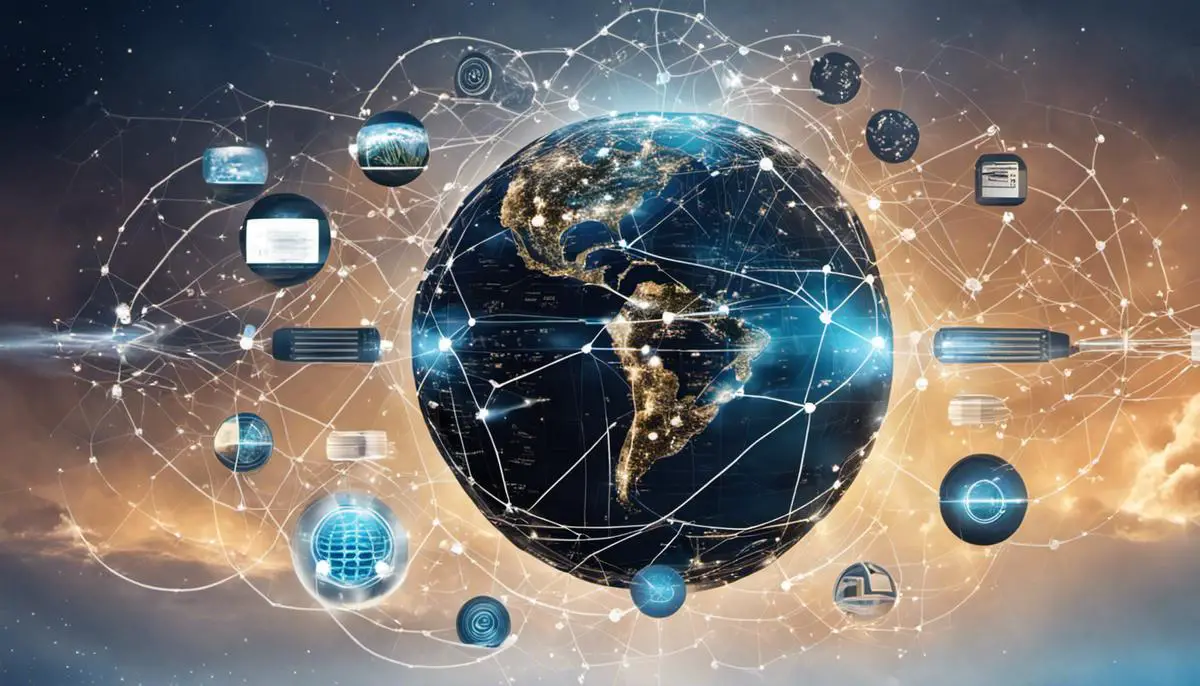Deepening our comprehension of artificial intelligence (AI) and its jurisdictive aspects has become critical, considering its pervasive impact on society. Our exploration begins with understanding the central concept of AI, from its evolution to its real-world applications, providing a solid foundation to appreciate its revolutionary implications. The emphasis then shifts to shed light on the significant need for AI regulation, probing into the ethical, moral, and privacy considerations it carries. We delve into the global aspect of AI regulation, encompassing the various strategic approaches taken by nations worldwide and exemplifying their regulatory measures. Pursuing further, we investigate potential regulatory outlines for AI, including evaluation of their scope and limits.
Concept of Artificial Intelligence
The term “Artificial Intelligence” (AI) is ubiquitous in today’s progressive world. But, unlocking its intricacies demands expertise and dedication. The area of AI is a complex mix of various domains of computer science, mathematics, cognitive psychology, and even philosophy. Therefore, gaining a comprehensive understanding of artificial intelligence involves venturing into numerous interconnected sectors.
To start, AI is primarily constructed on the foundation of computer science. Understanding algorithms, data structures, and systems architecture remains integral to the comprehension of how AI can process data at extraordinary speeds and efficiency. Furthermore, knowledge of computer languages is essential to actualize the conceptions of AI in the form of machine learning algorithms, decision-making models, and robotic automation.
Next, a solid grasp of mathematics provides the key to unlocking various corners of the AI universal room. Without a foundation in linear algebra, statistics, and calculus, AI would be akin to a high-performance car without the fuel to propel it forward. For example, the statistical models form a basis for machine learning algorithms that enable pattern recognition and prediction.
The study of AI doesn’t end with sheer computation and numbers. It further interlinks with a fascinating realm of cognitive psychology. A comprehensive understanding of AI also entails diving into the depths of human intelligence and behavior. The aim is to comprehend and replicate human intelligence as closely as possible – hence the importance of understanding perception, cognition, memory, and emotion. It is a much-overlooked field, but one where exciting research is underway, to help create AI models that mimic human decision-making patterns.
Moving beyond the scientific domains, the role of philosophy can’t be negated either. Questions pertaining to ethics, consciousness, and free will often arise in AI discussions. Unpacking AI fully involves considering these philosophical questions to guide the direction of AI’s development and prevent undesirable consequences, thereby enriching the conceptual understanding.
While we discuss these multifaceted aspects connected to AI, it also becomes evident that understanding AI is not just acquiring knowledge, it involves developing a skill. AI professionals need to learn how to handle big data, develop algorithms, adjust strategies based on outcomes, and continue the cycle iteratively in pursuit of perfection.
It’s essential to note that each deep dive into the AI pool presents yet another layer of depth and complexity, in the attempts to replicate and surpass human intelligence. Interestingly, every solution raises new questions and every answer creates a thirst for further understanding. A comprehensive understanding of artificial intelligence, therefore, doesn’t merely entail knowledge of various domains, but an amalgamation of passion and curiosity that drives continuous exploration of this ever-expanding field of study.

Importance of AI Regulation
Regulatory Frameworks: A Key Aspect of Artificial Intelligence Use
To engage fully with the intriguing world of artificial intelligence (AI), thorough understanding requires an exploration beyond the realms of computer science foundation, cognitive psychology connections, and philosophical debate. As pertinent as these areas are, there is an equally essential factor that demands close scrutiny: the regulation of AI. The immediate question that arises may be why this regulation is so integral to the safe utilization of AI?
Artificial Intelligence represents a revolution on par with the advent of the internet or electricity. True to its disruptive nature, it presents potential risks when interacted with in uncontrolled environments. AI systems, due to the inherent complexity in their algorithms and system architectures, can lead to unpredictable outcomes once deployed. The current technology world is transitioning from rule-based systems to AI-based systems where decision-making has moved from human operators to machines. Thus, unforeseen complexities can arise, which, in the presence of inappropriate system architecture or poorly crafted algorithms, might become barriers to the safe usage of AI.
Moreover, AI has significant societal implications, particularly in terms of privacy and surveillance, which can be exploited without proper regulation. From an ethical perspective, the rise of AI has brought about novel challenges regarding data privacy, security, consent, and potential misuse. Personal data could be inadvertently or purposefully misused in the absence of legally binding AI regulation. As AI’s reach extends to various societal sectors, these concerns are not merely hypothetical but represent very real threats to a person’s fundamental rights.
Academic circles further contend that AI can amplify existing biases present in society due to data insensitivity, which could lead to harmful discriminatory effects. Biases in data are typically the result of historical social constructs or even unconscious human prejudices. Without comprehensive regulation, such sensitivities may remain undetected due to the lack of knowledge about how an AI system’s decisions are influenced and made.
Consequently, the field of artificial intelligence requires a multifaceted form of regulation. It needs to deal not only with the technical aspects regarding AI safety and reliability but also touch upon issues related to ethics, equity, and societal impact. Such a comprehensive framework would play a pivotal role in mitigating the negative aspects of AI while promoting its beneficial utilization within society. Furthermore, this type of robust regulation encourages accountability, fosters trust, balances power, and forms a basis for legal recourse in case of harm caused by AI.
It is important to note that the primary goal of such regulation is not to stifle AI development. Instead, it seeks to establish guidelines that enable the continued evolution of AI while ensuring its adaptation within a human-centric framework. AI, as an emerging domain with immense potential, yearns for exploration fueled by passion and curiosity. However, to fully embrace the opportunities it provides, balancing the scientific, ethical, and societal considerations anchored in regulatory frameworks is a necessity. Only by doing this can society tread the path to the safe utilization of artificial intelligence, turning the AI revolution into an evolution that fortifies human life.

Global Perspective on AI Regulation
As we delve into the rapidly unfolding saga of artificial intelligence regulation, it is crucial to recognize the current global stance’s multifaceted character. From the corridors of academia to the convoluted labyrinth of legal policies, the regulation of AI is an intricate dance that straddles the blurred line between technological advancement and societal implications.
Critical strides have been made globally to create cohesive regulatory frameworks for AI. Various international bodies, national governments, and independent think tanks all work tirelessly, often in collaboration, to navigate the complex maze of AI regulation. The primary objective is clear – to balance the unfettered growth of AI technologies while safeguarding societal norms, ethical guidelines, privacy rights, and security imperatives.
In the European Union, the European Commission’s 2021 proposal for a regulatory framework, for instance, aims to create a ‘European approach to artificial intelligence’ that is guided by the region’s shared values and economic growth strategies. These draft regulations are centered on creating an ecosystem of trust and excellence in AI, addressing high-risk AI systems, establishing national supervisory authorities, and imposing substantial penalties for non-compliance.
Across the Atlantic, in the United States, the National Institute of Standards and Technology (NIST) has developed an AI Risk Management Framework that solicits global input. The aim is to cultivate a trustworthy yet innovative approach, contributing toward AI conduct standards that influence future state, national, and international policies.
Meanwhile, the Chinese government released its New Generation Artificial Intelligence Development Plan in 2017, demonstrating a strong commitment to leading global AI regulation. This plan encapsulates China’s ambitions of becoming the world leader in AI by 2030, thus transforming the nation into an ‘innovation center for AI.’
Additionally, the United Nations’ activities focus on maintaining international peace and security, including understanding the impact of AI and other technologies. At the World Intellectual Property Organization (WIPO), global discussions are underway on exploring the intersection of artificial intelligence and intellectual property policy.
Yet, in the bustle of drafting regulatory guidelines, paradoxes often emerge. Is it feasible to balance swift AI development with intricate regulatory processes? Can privacy preservation coexist with the upsurge in data-driven technologies? Crafting effective AI regulation has become a Herculean task, demanding a thorough understanding of technological nuances, a firm grasp of ethical boundaries, and a discerning insight into societal dynamics.
In conclusion, the current global standpoint on AI regulation reminds us of its precarious nature — a high-wire balancing act, an ongoing evolution, an intricate web of incremental steps channeled towards a more controlled yet profound exploration of artificial intelligence. As public and private entities worldwide grapple with the challenges and opportunities presented by AI, the focus remains firmly on devising comprehensive yet flexible regulatory frameworks to ensure the technology evolves beneficially for all.

Regulatory Measures for AI
As we contemplate the regulatory measures necessary for the appropriate development and application of AI, we must also consider their dimension and scope – local, national, and global. Bounding the development of AI with thoughtful, evidence-based regulations is a challenging endeavor that requires dexterity, as artificial intelligence is not limited by geographical boundaries.
One commendable step forward is the European Union’s proposed Artificial Intelligence Act. Underpinning this legislation is the principle that AI should work for the benefit of humanity while respecting the numerous complexities and nuances associated with its implementation. The European Union’s proposed framework gravitates towards ‘high-risk’ AI uses that might interfere with people’s safety and rights. These uses will be subject to compliance checks before they enter the market.
In the United States, the National Institute of Standards and Technology (NIST) has established the AI Risk Management Framework. This voluntary framework embodies responsible development and use of AI, fostering robustness, resilience, and rigorous implementation of guidelines that align with ethical principles.
Presently, China, a powerhouse in the field of AI, has committed itself to leading global AI regulation, emphasizing the development of ethical norms and standards. However, striking a balance between innovation and control has proven to be a delicate exercise.
The United Nations and the World Intellectual Property Organization (WIPO) have also embarked on activities to address issues related to AI and intellectual property. Their endeavors signify the importance of protecting intellectual property rights within the AI framework, reflecting the interconnectedness of innovation, law, and ethics.
Crafting effective AI regulation, however, is fraught with paradoxes and challenges. On one hand, there is the need to stimulate innovation for the advancement of society and technology. On the other hand, drawing a regulatory perimeter around AI is necessary to safeguard human rights and mitigate the risks associated with its misuse.
AI regulation is an ongoing evolution – a precarious dance between fostering innovation and providing safety. Regulatory bodies must acknowledge the potential pitfalls of both over-regulation, which may restrain technological advancement and under-regulation, which could lead to potential exploitation and misuse of AI.
The fabric of AI regulation needs to be comprehensive, flexible, and adaptable. It must address potential harms and mitigate risks, but should also be designed to evolve along with advancements in technology. Flexibility, in this context, means the ability to adapt and change with technological progress, always striving towards an ethical and beneficial direction.
In conclusion, when contemplating measures to regulate the development and application of AI, we must seek balance. We need to encourage the innovative spirit that stands at the heart of AI while ensuring safeguards are in place to protect society’s interests. This necessitates extensive cooperation, evidence-based discussions, and a shared commitment throughout the global community to develop comprehensive regulatory frameworks harmonized with the rapid pace of AI evolution.

Challenges in AI Regulation
As we delve into the intricate labyrinth of Artificial Intelligence (AI) regulation, it is important to throw light on some of the key challenges that regulators are expected to face. These challenges fundamentally revolve around striking a balance: between promoting innovation and ensuring the technology is used ethically and responsibly, and between the local, national, and global implications and considerations of AI.
The first challenge stems from the continually evolving nature of AI technology; it is a field marked by rapid and unpredictable advancements. This intense pace of growth makes it difficult for regulators to keep up, and even more challenging to frame regulations that are forward-looking, taking into consideration not just the current state of AI but potential future directions it could take. Regulations that are too specific may become obsolete swiftly, while those that are too general may leave dangerous loopholes.
A vivid example of this challenge can be observed with AI systems that leverage machine learning. These systems learn autonomously, and their decision-making processes can become impenetrably complex, rendering them a ‘black box’. Imposing regulatory control on these ‘black box’ phenomena gestates a series of conundrums. How, for instance, can regulators ensure transparency and accountability when the decision-making process is concealed within layers of algorithms?
Another apparent challenge is the global nature of AI technology. AI systems and applications are rarely confined to one country. Data processed by an AI system can seamlessly travel across borders, further complicating regulatory efforts. National laws may prove insufficient in a world where AI applications can have instant and far-reaching international implications. This necessitates multilateral cooperation on a global scale, a feat that is notoriously difficult given differing national interests and varying stages of AI development among countries.
The conversation around AI ethics and human rights presents its own set of challenges. Existing regulatory gaps have allowed the pervasion of AI systems prone to amplifying biases and discriminations, leading to unjust outcomes. Regulations will need to tackle these issues robustly without curtailing the revolutionary potential AI carries for societal transformation. Moreover, the protection of individual rights, particularly privacy, in the era of AI remains an unsolved problem. Balancing the capabilities of AI with preserving individual’s personal liberties is an area that will see much debate.
Finally, defining and enforcing liability in instances where AI systems fail or cause harm, whether physical or virtual, casts a daunting challenge. The fluidity with which AI systems can adapt and learn makes it hard to pinpoint responsibility. This calls for novel ways of assessing liability commensurate with AI’s distinctive capacities.
In summary, regulating AI poses its own unique set of challenges. Navigating these will require a judicious blend of technical understanding, legal acumen, ethical consideration, and diplomatic negotiation. History has shown that regulation can stifle or stimulate innovation. The task now is to ensure the evolution of AI benefits all of humanity while mitigating its potential risks.

As AI continues to evolve at a rapid pace, inherent challenges in its regulation become apparent, demanding an astute balance between encouraging technological advancement and protecting societal values and legal norms. These practical issues are heightened by the accelerated rate of AI development, the requirement for global coordination, ensuring competitiveness, and the risk of over-regulating. Our discussions span these regulatory obstacles, aiming to grace the balance between ensuring a free-racing AI innovation, while flagging potential hazards to guide preemptive measures. The conversation on AI regulation remains a necessity, as it will influence not only our immediate future but also the long-term trajectory of humanity and its interaction with technology.
Writio: Your AI content writer! 🤖📝 This article was crafted with precision and creativity by Writio – the innovative platform revolutionizing web content.




